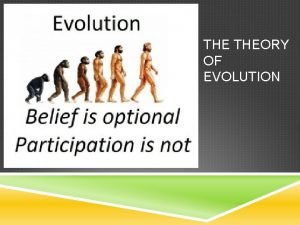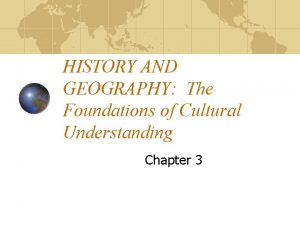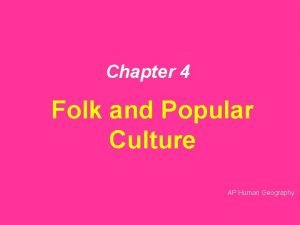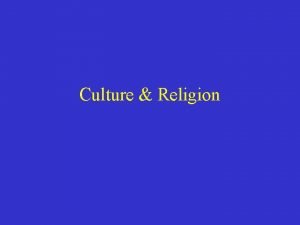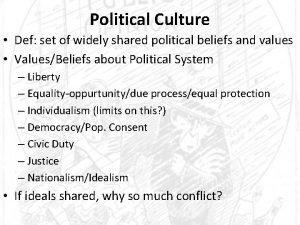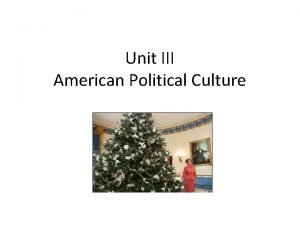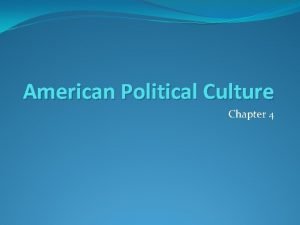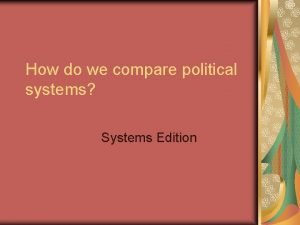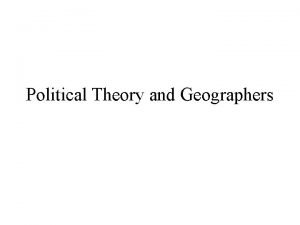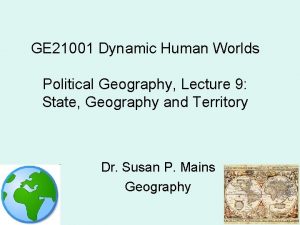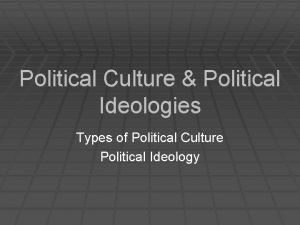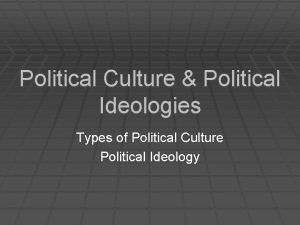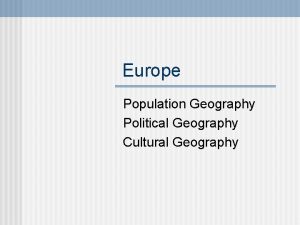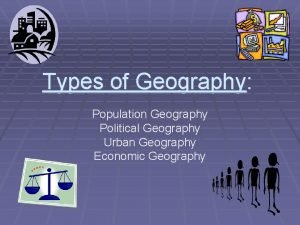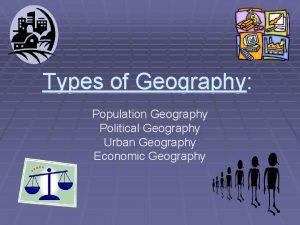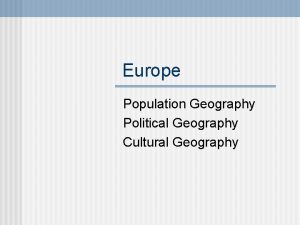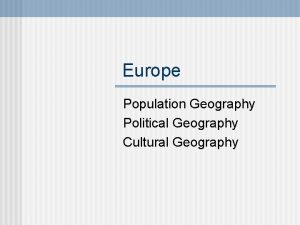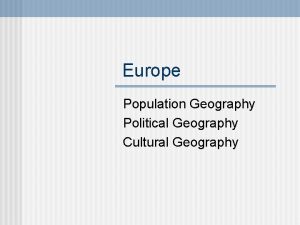Political Culture Evolution of the State Political Geography







































- Slides: 39

Political Culture & Evolution of the State: Political Geography • Brief History of ‘state’ and ‘sovereignty’ • Terminology • Characteristics of states • Composition of states • Functions of boundaries

Introduction • Political culture- every bit a component of a people as language or religion • People adhere to political ideas as they would other cultural components • Political systems are either secular, nonsecular or based entirely on religion− Theocracies- political laws and leaders under divine guidance

Key Points of Focus • Roughly 200 States on globe • The modern State system is product of Euro roots-Sovereignty and Nation-state • Concepts of Nations and States differ-historically • State territory varies in size/shape • State territories defined by international boundaries • What makes states react the way they do to

Can Europe create powerful/economic union despite Nationalistic concerns?

Russia struggles for identity and new place in world

The Balkans War, genocide and refugees during 1990 s

Israel/Palestine- Is Peace Possible?

Chechnya-Russia Independence for this small Russian province?

Can China create political and social institutions that allow for continued growth?

U. S. in Iraq and Afghanistan: What is the best means to deploy U. S. influence?

Geography and Political Organization

Territoriality • How can it be explained? − Effort by some to control pieces of earth surface for political means − Instinct in humans, like animals • Or, different circumstances arise that need to be analyzed separate from each other • How are different territoriality strategies pursued and when

State and Nation: Terminology • State and country are interchangeable • State: Latin meaning Status • Some countries have internal divisions called states- like provinces (Canada) or territories (Australia) • A nation may be larger than a state • Nation has historic, ethnic, linguistic and religious connotations • Many states are states, but not nations (in traditional sense of word)

Traditional Pillars of a Nation Common language Common history; not as a country but as a people Same ethnic background Common rule of law/gov’tal institutions

Are there Nation-states? • Virtually all states are characterized by internal diversity • Even in culturally heterogeneous states vast majority of people share strong sense of ‘nationalism’ or national spirit • National spirit is contemporary way of viewing the concept of ‘nation’

Stateless Nations • Many countries are states, but not nations • Not one Nation-State exists in 2010 - even France is not a Nation-State • People w/out a state are Stateless-Nations − Palestinians, Native American tribes, Kurds − The mere fact Stateless-Nations exist is not vital, the problems that occur because some are stateless is problematic − The problems that exist is why the study of Stateless-Nations is important

Kurds are example of stateless-nation

Multi-Nation State • Republic of Cyprus

Rise of the Modern State • The Euro Model − On Euro Continent the strength of rulers produced nat’l cohesiveness − Economic revival sparked in 13/14 th century & Dark Ages passed − Treaties signed at the end of the Thirty Years’ War laid foundation for state and sovereignty − Western Europe’s strong monarchies began to represent something greater than authority − Renaissance led to greater prosperity, knowledge and wealth − City-based merchants became more influential; cities grew in importance; land as measure of affluence lost

The Nation; the State; Sovereignty • Sovereignty: power rested in the hands of the people; the nation • Emerged after Thirty Years’ War • Each nation should have its own sovereign territory • Europe controlled much of world: − Defined, determined ground rules for emerging internat’l state system − End of Colonial period led many emerging states to model statehood after the Euro model

Spatial Characteristics of a state • Physical and cultural properties: − States differ in as many ways as they are similar − Vast differences in size and population − State is a complex system & spirit of state is fragile − Boundaries often throw together people of various cultures and ethnicities; false sense of belonging − To succeed, a state must foster sense of legitimacy − In order to be considered a state: • Clearly defined territory • Substantial population • Authoritative/gov’t institutions • Recognized by other powers- Example: Northern Turkish Republic of Cyprus (only recognized by Turkey); is it really a sovereign state if only recognized by Turkey?

Territory • State must have territory to exist • Territorial Morphology- size, shape, and relative location vary from state to state • Territorial characteristics can and do pose opportunities and challenges • Large states have greater chance of having wide range of environments and resources • United States’ abundance of natural resources have enabled it to be the power it is in late 20 th century and early 21 st • Former Soviet Union had abundance of resources, but too many obstacles to adequately

Territorial Morphology State Shapes and Forms

Name that Shape!!

Relative Location State that must traverse, at least one other, for access to the sea • Can have more effect than size and shape of country • Resource-rich location • Relation to global mainstream of activity • Enclave and Exclaves • Landlocked- face locational challenges(9 of 20 poorest nations landlocked) * according to Global Facilitation Partnership for Trans and Trade • Political instability of coastal neighbors is problematic Soil loss in Mongolia

Enclaves/Exclaves

Landlocked • 2008: 44 landlocked countries • Country is cut from sea business: fishing & international trade

Establishment of Boundaries Size, Shape & Location Evolution of boundaries Boundary types

States Differ • Territorial size • Shape • Demography • Regime • Organizational Structures • Resources • Development

Relative Location • Size & shape do not determine political, social, economic well-being • One must consider a country’s location on globe • Location can/will determine a country’s foreign policy

Evolution of Boundaries • Three Stages • Agreement is reached and exact location is established—Definition • Cartographers place boundary on map— Delimination • Borders marked by walls, fences, etc. . — Demarcation − Not all boundaries are demarcated though

Functions of Boundaries • Walls used to keep people from moving across boundaries • Today- boundaries mark the limit of state jurisdiction • Serve as state symbols of sovereignty and foster nationalism

Internal Boundaries • Needed for administrative purposes • Examples: United States, Canada, India • Some countries have cultural divides that do not show up on ma − The Former Yugoslavia is case-in-point

Boundary Disputes • Typically exist from following four: − − Definition Location Operation Allocation

Land Boundaries • A boundary is a Vertical Plane • Cuts through subsoil and airspace • Becomes problem when referring to resources— coal, oil, natural gas

The Former USSR • 100 ethnicities and two predominate religions • Armenia- Christian, Azerbaijan- Muslim • Soviets squelched religion • Set up boundaries that would allow control • Enclaves/exclaves created to keep religions together • Soviet control crumbled leaving war and conflict


Types of Boundaries • Lines of latitude and longitude • Rivers, Mountains, deserts • Geometric Boundary—straight line boundaries • Physical-Political or Natural-Political − Natural characteristics of land provide border − Rio Grande, Great Lakes, Pyrenees

Cultural-Political Boundaries • Boundaries that are created to keep certain ethnicities and/or nationalities together • USSR in Armenia and Azerbaijan • Yugoslavia-Croatia, Serbia, Slovenia, Bosnia, Macedonia, Albania
 Ap human geography political geography frq
Ap human geography political geography frq Ap human geography political geography test
Ap human geography political geography test Nicholas spykman rimland theory
Nicholas spykman rimland theory Non material culture examples
Non material culture examples Sociologists define a symbol as
Sociologists define a symbol as Batch culture vs continuous culture
Batch culture vs continuous culture Fed-batch
Fed-batch Characteristics of collectivism
Characteristics of collectivism American culture vs indian culture
American culture vs indian culture Uses of selenite f broth
Uses of selenite f broth Folk culture and popular culture venn diagram
Folk culture and popular culture venn diagram Sub culture group
Sub culture group Chapter 4 folk and popular culture
Chapter 4 folk and popular culture Tsi
Tsi Homework due today
Homework due today In an inert organizational culture,
In an inert organizational culture, Stroke culture method
Stroke culture method Lawn or carpet culture
Lawn or carpet culture Laying the foundation for a quality culture
Laying the foundation for a quality culture Surface culture deep culture and esol
Surface culture deep culture and esol What does the theory of evolution state
What does the theory of evolution state History and geography the foundations of culture
History and geography the foundations of culture Folk culture definition ap human geography
Folk culture definition ap human geography Distribution of religions in the world
Distribution of religions in the world Folk culture ap human geography
Folk culture ap human geography Tracking polls def
Tracking polls def American political culture definition
American political culture definition American political culture definition
American political culture definition Political culture of texas
Political culture of texas What is political culture
What is political culture 5 themes of geography ap human geography
5 themes of geography ap human geography Genetic boundary definition
Genetic boundary definition Objectives of political geography
Objectives of political geography Population density map australia
Population density map australia Relationship between political science and geography
Relationship between political science and geography Contemporary political boundaries
Contemporary political boundaries Political geography
Political geography Compare geometric boundaries and antecedent boundaries.
Compare geometric boundaries and antecedent boundaries. Political geography
Political geography Centrifugal force in geography
Centrifugal force in geography




















